In today’s competitive landscape, your business needs to leverage as many distribution channels as possible to increase sales.
By now, I’m sure you understand the basic concepts of applying a social media marketing strategy.
You’ve created business profiles on the most popular networks. You’re sharing content on a regular basis. Your efforts have helped you get more followers.
But you’ve got to elevate your game and learn how to convert your social media followers into customers.
According to research, 74% of consumers use social media to guide their buying decisions. And 71% of people are more likely to buy something based on a social media recommendation.
Simply put, consumers are eager and willing to use social platforms to find new brands, conduct research, and aid the purchase process.
As a marketer, you need to recognize the latest social media trends and use them to your advantage.
Instagram is the fastest growing social media platform. This social network makes it very easy, friendly, and appealing for brands to reach their target audiences.
Take advantage of everything Instagram has to offer. I’ll show you the top 11 ways to drive sales on Instagram.
1. Run contests and giveaways
Promotional contests and giveaways are two of my favorite strategies for brands to engage with their audiences on social media.
If you can learn how to run a profitable giveaway, your efforts will result in more sales.
I know what some of you are thinking. How can you make money by just giving away your products?
Let’s review an example to show you what I mean. Here’s a look at how Lander used this strategy on a recent Instagram post:
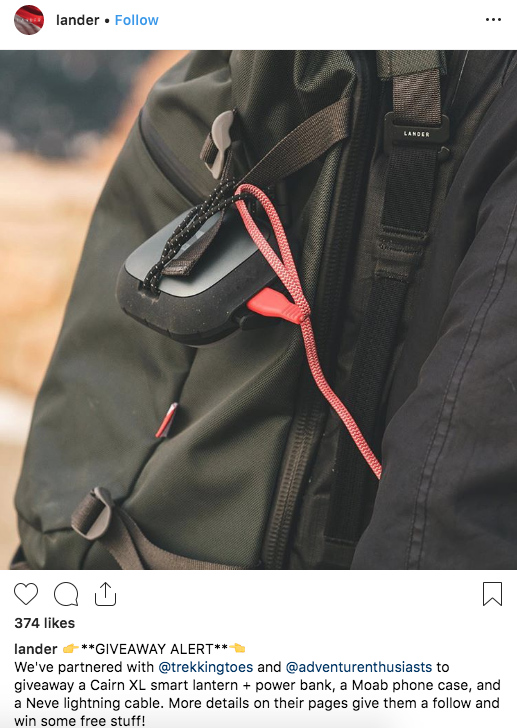
The company is giving away a smart lantern, power bank, phone case, and lightning cable.
Doing this increases the exposure of its page. It gives people a reason to follow its profile and engage with the brand.
As you can see, this giveaway is a bit different from the ones you may have seen in the past. Lander partnered with other brands to sponsor this giveaway.
Again, this strategy will drive more users to its page. These other accounts will post information about the giveaway and direct users to follow Lander’s profile to win.
Here’s a look at the caption from one of the other accounts it partnered with:

There are plenty of other ways to get creative with this marketing tactic.
Instead of giving away items at random to your followers simply for liking a post and following your account, you could run a more structured contest that requires skill.
Contests that encourage user-generated content are the most effective.
To enter, ask your followers to upload a picture and tag your brand. This strategy will expose your company to anyone who follows the users who enter.
If someone sees that their friend is promoting a brand, they’ll be more inclined to follow your profile and potentially enter the contest as well.
Now that you’ve got these users interested in your products, you can use other strategies to get them to buy. Even if they didn’t win the contest, the product you were giving away is still on their minds.
2. Take advantage of the “swipe up” feature
The swipe up feature is a game-changer for businesses.
For years, you probably had some trouble getting users on Instagram to navigate to your website from a specific link. You would post content and then direct people to click a link in your bio.
But that strategy has lots of faults.
First, it’s an extra step for the user. They have to navigate to your profile page and then make another click.
People don’t want to go through that hassle.
Plus, what if you want to promote two different landing pages? Or maybe three? or four?
You will not have multiple links in your bio. That’s too confusing.
The swipe up feature eliminates this problem. Now you can use your Instagram story to drive traffic directly to specific landing pages.
Here are a couple of examples:
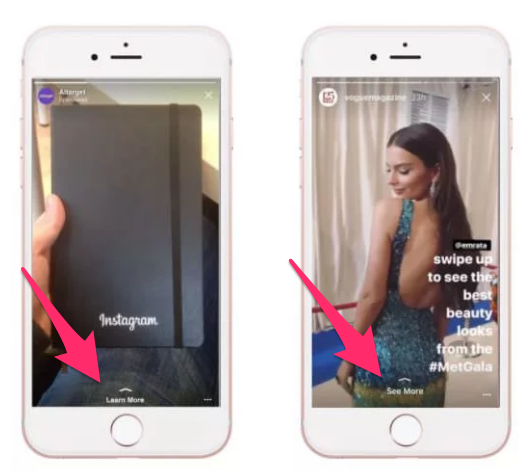
Once your business profile reaches 10k followers, you’ll have access to this feature.
Just promote a product or service on your story, and add the swipe up function with a link to a landing page about your promotion.
If you’re advertising a specific product, a logical landing page would be to the product description on your site. There, the user can look at additional photos and add the product to their shopping cart.
These lead magnets are a great way for you to drive more traffic to your website and ultimately increase conversions.
3. Use shoppable posts
If you have an ecommerce brand, you need to take advantage of shoppable posts.
This strategy allows you to sell products directly through the Instagram platform.
The reason why I love this feature so much is because it increases the chances of getting your current and prospective customers to buy something. Here’s why.
Right now, you’re relying on consumers navigating to your website to buy your products.
This can be from organic traffic, paid ads, or direct navigation.
The problem is that people probably won’t do this every day. But they’re active on Instagram daily.
In fact, 500 million people use Instagram on a daily basis. So there’s a great chance your target market falls into this category.
Here’s an example of a shoppable post from Patara Shoes:

It’s simple. This post is just a regular image that includes one of the brand’s products.
You also see a tag of the product by name, the price, and a link to purchase it. All someone has to do is click on the tag, and they’ll be directed to the website.
This is much easier than having to manually search for the product by opening a web browser. Shoppable posts increase conversions.
Check out the caption. It’s creating FOMO—the fear of missing out. I’ve discussed this strategy in the past.
Telling users they have only a few pairs of these shoes left nudges them to buy right now.
If you’ve never sold products on Instagram before and don’t know where to start, check out my complete guide on how to increase your ecommerce product sales with shoppable posts on Instagram.
4. Post the same product more than once
If you post a product once and then never promote it again, people may forget about it.
Think about the way users behave on Instagram. They quickly scroll through their feeds.
The first time they see your product, they may not have a reason to buy it. But if they see it more than once, it may start to pique their interest.
According to a study from Sprout Social, more than 60% of people need to see something on social media between two and four times before they buy it:
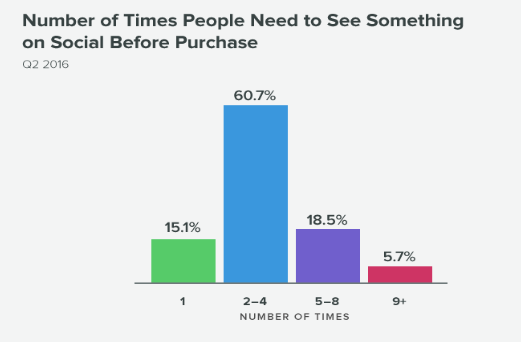
I’m not saying you should post the exact same image four different times on your Instagram page. That’s boring and might even cause people to unfollow you.
Get creative.
Start with a post of just the product. A few days later, you can share another image of the product on your Instagram story.
The following week, run a contest to promote the same product. Weeks later, you can share a video of the same item being used in a demonstration.
Posting the same product multiple times increases the chances of people buying it.
5. Partner with social influencers
Using social influencers to promote your brand, products, and services is an extremely efficient tactic.
In fact, 94% of marketers say their social influencer strategy was effective for their companies.
That’s because social influencer followers trust them.
We know that 82% of people are likely to follow recommendations made by micro influencers. And 94% of consumers believe these influencers are highly knowledgeable.
Basically, if you can get an influencer to promote your brand, you will get sales.
Instagram is the primary social platform for influencers across the globe.
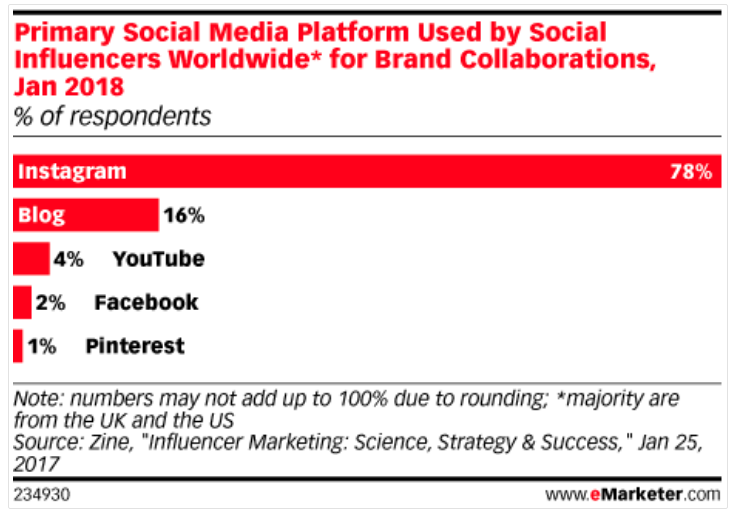
This is a cost-effective marketing strategy.
Most influencers will charge only a few hundred dollars or so for a post. However, if you’d rather work with celebrity influencers, be prepared to spend significantly more.
But for the most part, that’s not necessary.
I recommend looking for influencers who have between 10k and 50k followers. These people have more authentic interactions with their followers and higher engagement rates.
Plus, the cost per post will be less.
If you’re struggling to find the right influencer to promote your brand, review the top 10 platforms for effectively managing social influencers.
6. Respond to comments and messages
I know it may seem like a time-consuming and tedious task, but you need to respond to your followers on Instagram.
By responding directly to comments on your post, you will add a human element and personal feel to your brand, which people really appreciate.
This strategy is especially important if people are asking questions or voicing complaints about your business. Respond to these comments as fast as possible to come up with a resolution.
It shows other users who see your responses on social media that your brand values customer service.
Consumers are willing to pay more for good service. You can expect to see an increase in sales by communicating with your customers effectively on social media.
7. Go live
The majority of the strategies I’ve discussed so far focus on Instagram posts. But that’s not the only way you can reach users and drive sales.
Like other social networks, Instagram has a live broadcast feature.
This is your chance to engage with your audience in real time.
Users can comment on your broadcast. Acknowledge those comments. Answer their questions. Show them you’re listening.
Social media users love watching live videos.

What’s a good reason to go live?
That decision is yours. But there are lots of different ways to get creative with these streams.
Give your followers a tour around your office. Introduce them to your employees. Show them how products get made at your manufacturing facility.
If your company is at an event, give your followers exclusive access to what happens behind the scenes.
This type of content will keep your audience engaged, get them excited about your brand, and ultimately increase the chances they’ll make a purchase.
8. Run targeted ads
How can you reach people on Instagram who don’t follow your account?
Some of the strategies, such as location tagging, running contests, and working with social influencers can accomplish this.
However, those strategies don’t always expose your brand to people within your target market. Running targeted advertisements will do this.
Instagram has been acquired by Facebook. You can set up your ads the same way on both networks.
You can use parameters such as age, gender, and location to select your ad audience. You can even take that one step further and target users based on their interests.
Here’s an example of a targeted Instagram ad from Tentree:

As you can see, this post looks like any other post on Instagram. The only difference is that it says “sponsored” where the location tag would normally be, and there is a CTA button at the bottom.
But when a user is scrolling through their feed, this post blends in with the rest of the content they’re consuming. It’s not invasive or annoying.
Yes, you’ll have to pay if you want to run Instagram ads. Those of you who don’t have the funds in your marketing budget for this right now would want to stick with the free strategies on this list.
However, if you can afford it, I recommend at least trying it out to see how it works for you. This can be a great way to drive sales by reaching a new audience.
9. Use your story to showcase products
Earlier I mentioned examples of posting content to your Instagram story.
But now you can use your Instagram story to sell your products the same way you did with shoppable posts.
As of June 12, 2018, Instagram brought the shopping feature to stories.
Here’s a look at an example from Madewell:
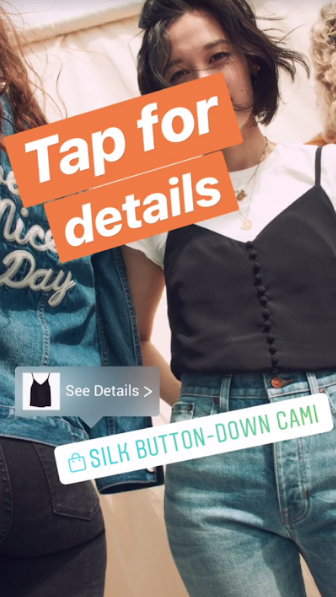
As you can see, the post is promoting a silk button-down cami.
Since the shopping feature on stories is new, the post features additional text as a way to tell the users the post is clickable.
If you tap on the button as instructed, you’ll be redirected to the brand’s website. From here, you’ll have an option to buy the product displayed in the story:
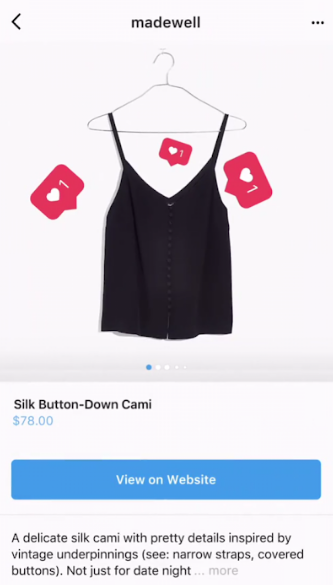
Use this strategy if you’re running an ecommerce shop.
As I said before, people need to see a product multiple times on social media before they decide to buy it. Add shoppable stories to the list of ways to showcase your products.
10. Connect your followers to your Facebook page
If your company has an Instagram profile, it probably also has a Facebook page.
Since Instagram was acquired by Facebook, these two platforms have lots of features that work together. I mentioned this earlier when I talked about running targeted ads.
Now you can sync your Instagram followers with your Facebook business page.
Once this process is complete, you can use messenger bots to nurture those users.
There are more than 300,000 active monthly bots on Facebook messenger. Clearly, other businesses are taking advantage of this strategy already.
Jump on board now before your competitors’ bots steal your customers.
11. Offer discounts to your followers
Everyone loves a good deal.
Share discounts with your followers on Instagram to encourage them to buy.
Instagram is a great platform for running flash sales. Since your story disappears after 24 hours, you can use that type of post to share a promo code.
This will make your followers feel as if they’re getting an offer other people don’t know about. That feeling of exclusivity will also encourage them to buy.
Look at how J. Crew offered a discount in this post:

Notice anything different about this post?
The reason why I used this as an example is because it also uses another strategy I discussed on this list. This is a targeted advertisement.
Don’t think your promo codes should be limited to just your profile posts and stories.
Combining that deal with a targeted ad can be extremely effective. That’s because your ads will have CTA buttons bringing users directly to your website.
If someone clicks on the “shop now” button in the J. Crew ad, they’ll be able to use the promo code right away. This is much easier than having to navigate to a new window.
Conclusion
You can’t rely on website traffic alone to sell products. Take advantage of other distribution channels as well.
Social media influences consumers’ purchasing decisions.
Since Instagram is growing at such a rapid rate, it makes sense to use this platform as a primary method of driving sales.
Plus, as you’ve seen from this list, Instagram has features that allow businesses to sell items directly through its platform.
If your Instagram marketing strategy needs improvement, refer to this guide.
Once you implement these strategies, it will be easier to generate sales from Instagram users.
How is your business using Instagram to drive sales?

Source Quick Sprout https://ift.tt/2Cr6cMp











